Foot and Toe Pain
Pain in the foot can be felt either on top, bottom, or sides of the foot. There are many muscles that contribute to foot pain. A general complain in this area is achy feet and tenderness to the smaller muscles of the foot.

Causes
Hyperpronation: This describes an excessive inward rolling of the foot during walking or running. Over time, hyperpronation can contribute to pain and injury in the ankles, shins, knees, and even hips due to misalignment of the skeletal and muscular system.
Wearing shoes that are too tight: This can lead to a variety of foot and toe pain by constricting the foot and disrupting its natural function. The pressure from tight shoes can compress nerves and blood vessels, leading to sharp pain, tingling, and numbness. Furthermore, this constant pressure can contribute to the formation of muscle knots (myofascial trigger points) in the small muscles of the foot, which can cause localized pain and refer discomfort to other areas of the foot and toes. Over time, this constriction can also cause structural deformities like bunions and hammertoes, and alter gait patterns, potentially leading to pain in the ankles and knees.
Worn-out shoes: This can significantly contribute to foot and toe pain by altering your natural running and walking patterns. As the cushioning and support break down, your foot and ankle must work harder to absorb impact and maintain body stability. This extra effort can lead to the overuse of muscles in the calf and foot, which can promote the development of painful muscle knots. These knots not only cause localized pain but can also lead to instability and referred pain patterns, making you more susceptible to ankle sprains and chronic discomfort.
Muscle Overload: Your feet are the foundation of your body, and any issue can create a domino effect of muscle knots, pain, and imbalance that travels up to the ankle, knees, hips, and back. Muscle overload in the feet, often caused by repetitive strain, poor posture, or wearing ill-fitting shoes, can lead to pain and the formation of muscle knots. When muscles in the feet are subject to this chronic stress, they may become weak and prone to developing these painful knots, which can cause both localized and referred pain.
Uneven walking or running surfaces: Walking or running on uneven surfaces can significantly contribute to ankle pain and instability. The constant micro-adjustments your calf muscles must make to maintain balance on uneven surfaces lead to their overuse and a higher likelihood of developing muscle knots. These muscle knots in overworked calf muscles can then contribute to instability, making you more prone to ankle rolls or sprains.
Foot Pain
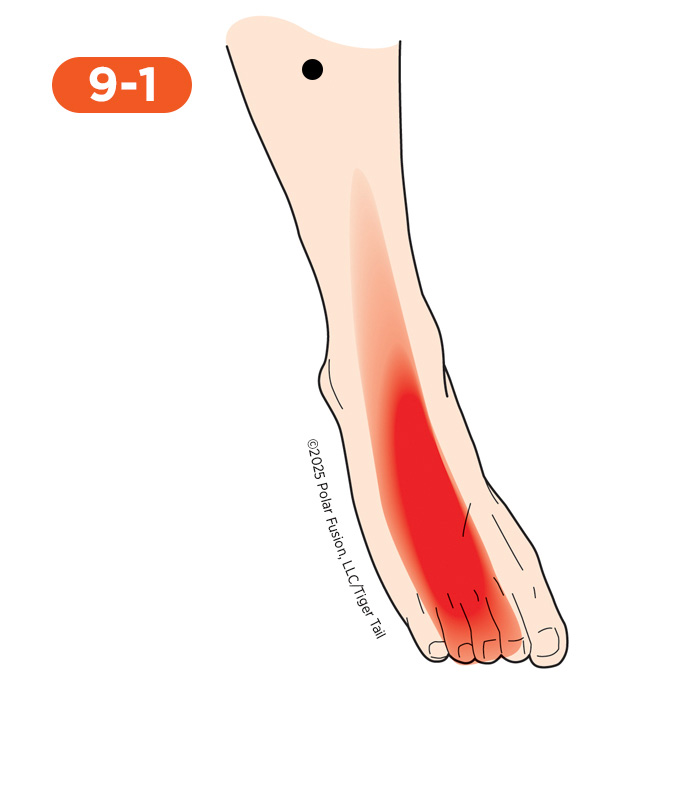
I Feel
Achy Feet
Suppose you’re experiencing overall achy feet that feel tired after a day of walking. The problem might be muscle knots in the long toe extensor muscle, the extensor digitorum longus. The discomfort usually centers on the top of the foot and ankle, presenting as a deep, dull ache that can spread across the whole foot, often worsening by evening. You may notice the pain intensifies during activities that repeatedly use the muscle, such as walking on uneven ground, running or jogging, or wearing tight shoes that cramp your toes. Since the extensor digitorum longus must lift the toes with each step, muscle knots here can closely resemble more serious issues, like general foot fatigue or stress reactions.
Achy Pain on Bottom of Foot
That confusing, achy pain at the bottom of your foot may be referred pain from tight muscle knots in the toe extensor muscle, the extensor digitorum. The discomfort typically concentrates deep in the arch or ball of the foot, presenting as a deep, chronic ache similar to a bruise. You’ll notice the pain worsens during activities that demand constant foot stability, such as walking barefoot, standing for extended periods, or pushing off to sprint. Since the extensor digitorum longus influences the entire foot, its muscle knots can easily mimic more serious issues like plantar fasciitis or metatarsalgia.
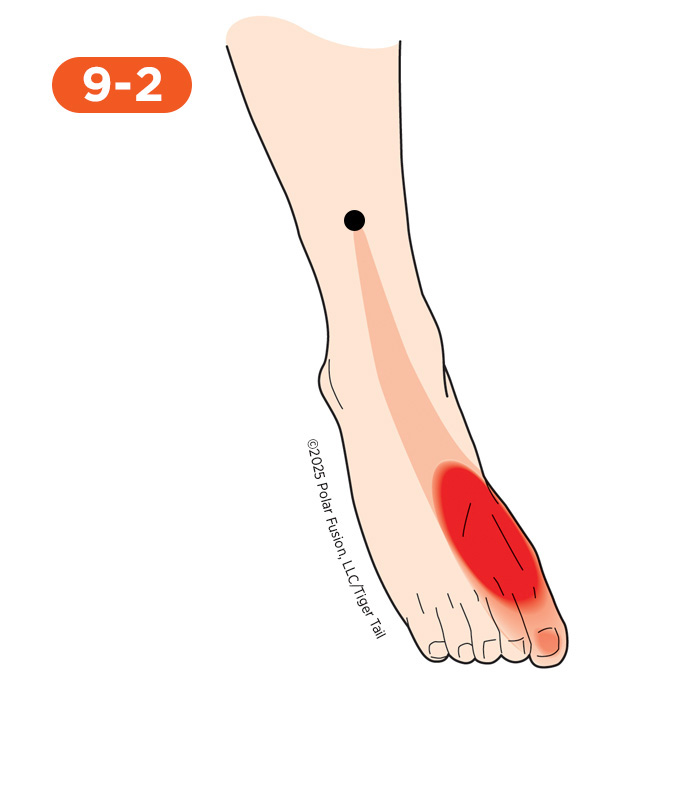
I Feel
Night Cramps
If you wake up with painful cramps near your big toe and ankle, especially at night, it’s likely caused by tight muscle knots in the muscle runs down the front of your shin and helps lift your big toe, the extensor hallucis longus tendon. When it develops muscle knots, it can cause sharp, intense cramping pain along the top of your foot and ankle. You might feel it suddenly seize up—especially when you stretch your toes in bed or stand up quickly after resting. That sudden movement can really worsen the muscle. Because the extensor hallucis longus plays an important role in lifting the big toe, tightness in this muscle can sometimes mimic more serious issues, like nerve irritation or an electrolyte imbalance. One sign is tenderness along the front of your shin—if pressing there feels sore, it’s often related. This kind of tightness can make your foot feel stiff and guarded, and it can be painful to move your big toe normally. It’s like your foot is bracing itself, which makes everyday movement uncomfortable.
Weakness
Weakness in your foot and toes can make it feel like you’re not fully in control of your own movements, as if your foot isn’t listening to your brain. This can be caused by muscle knots in the muscle that lifts your big toe, the extensor hallucis longus. You might notice your toes dragging on the ground when you walk, a condition known as foot drop, which can lead to a shuffling gait and an increased risk of tripping. This lack of control can make it difficult to lift the front part of your foot, making you more prone to stumbling. As a result, even simple tasks like climbing stairs or walking on uneven surfaces can feel tiring and unsteady.

I Feel
Achy Feet
Suppose you’re experiencing overall achy, heavy, and exhausted feet. The cause might be muscle knots in the small muscles on top of your foot—specifically the extensor digitorum brevis and extensor hallucis brevis. Typically, you’ll feel a deep, dull ache that spreads across the entire top of your foot, which usually worsens by the end of the day. The pain intensifies when walking on uneven ground, running or jogging, wearing shoes that press down on the top of your foot, standing for long periods, or engaging in activities that constantly involve your toes. Here’s the thing: because these muscles help stabilize your toes with each step, when they’re knotted, it can easily mimic more serious issues like tendonitis or general foot fatigue. You’ll probably notice that the top of your foot is very sensitive to pressure, and your entire foot feels restricted and tired.
Night Cramps
If you’re waking up with painful night cramps on the top of your foot and toes, the cause is often tight muscle knots in the small extensor muscles on the top of your foot, such as the extensor digitorum brevis and hallucis brevis muscles. The discomfort usually focuses along the top of the foot, appearing as a sharp, intense cramping pain that suddenly seizes the muscles. You’ll notice the pain worsens when you’re doing activities that rapidly stretch the muscles after inactivity, like pointing your toes sharply in bed or standing up quickly in the morning. Since these small muscles stabilize the toes, their muscle knots can easily resemble deeper problems, such as nerve irritation or severe electrolyte imbalances. The top of the foot is often sensitive to pressure, leaving the foot feeling guarded and restricted, and making it painful to move the toes.
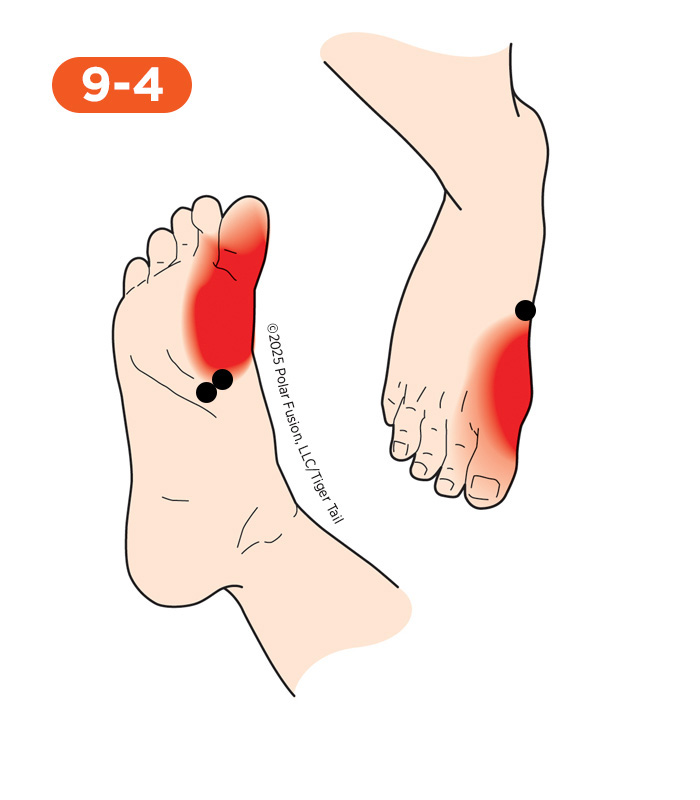
I Feel
Bunion Like Pain
That sharp, localized ache that feels exactly like bunion pain is often caused by muscle knots in the small, deep muscle underneath the big toe joint, the flexor hallucis brevis. The discomfort usually concentrates right at the base of the big toe joint, appearing as a sharp, pinching pain that worsens when pushing off. The pain tends to intensify during activities that extend the big toe, such as walking vigorously, running, or wearing flexible shoes that lack forefoot support. Since the flexor hallucis brevis stabilizes the big toe joint, its muscle knots can resemble deeper issues like bunion development or sesamoiditis. The area near the big toe on the ball of the foot often feels sensitive to pressure, and it leaves the joint feeling stiff and restricted, reducing your push-off power.
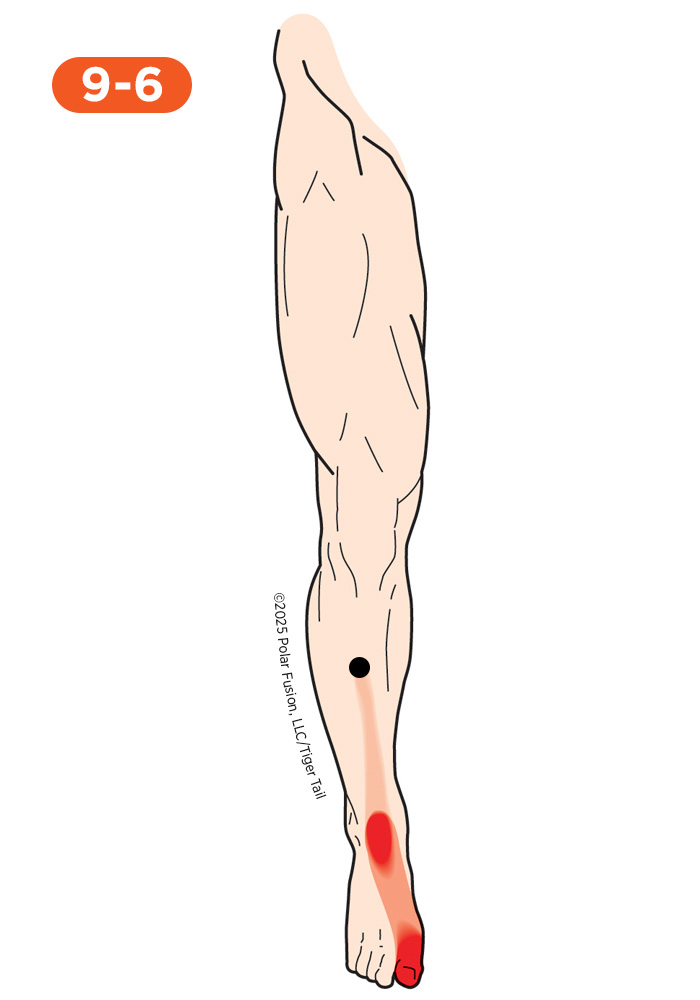
I Feel
Pain When Moving Ankle
That chronic pain when moving your ankle is often caused by tight muscle knots in the main muscle that brings the ankle towards the body, the tibialis anterior. The discomfort usually stays along the front of the shin and ankle, showing as a sharp, pinching pain when you lift your foot, followed by a dull throb. The pain can get worse during activities that repeatedly strain the ankle, like running, using the gas or brake pedals in a car, or walking on your heels. Because the muscle has to work hard to stabilize, its muscle knots can easily mimic more serious issues, such as ankle joint arthritis or tendinitis. The muscle belly along the shin can make the ankle feel tight and restricted, limiting how far you can lift your foot.
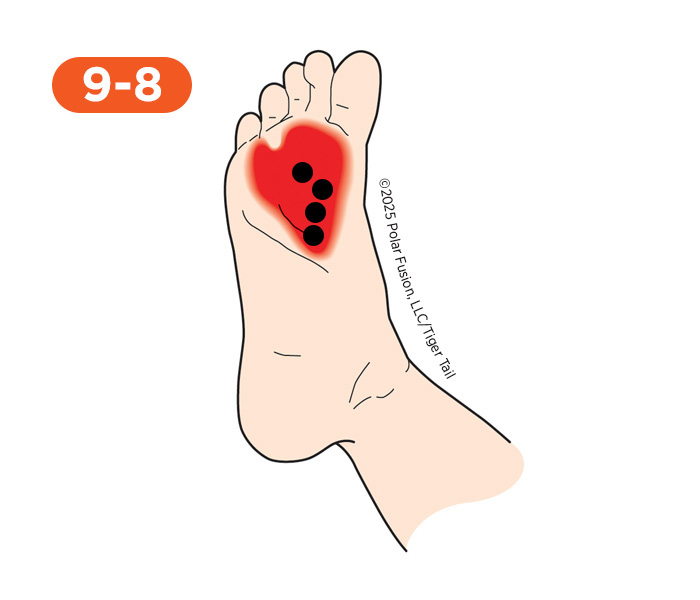
I Feel
Ball of Foot Pain
That painful ache across the ball of your foot is frequently caused by tight muscle knots in the deep, powerful muscle that pulls your big toe inward, the adductor hallucis. What you’ll typically feel is a sharp, pinching pain right across the metatarsal heads (that’s the area just before your toes) that feels worse when you’re standing or bearing weight. The pain gets significantly worse when you’re walking barefoot on hard surfaces, running, wearing high heels, doing lunges, or pushing off during activities like dancing or jumping. Here’s what’s really happening: because this muscle influences the entire structure of your forefoot, when it’s knotted up, it can easily mimic deeper problems like Morton’s Neuroma or metatarsalgia – conditions that often require more intensive treatment. You’ll probably notice that when you press into the tissue in your arch near the ball of your foot, it’s sensitive to pressure, and your whole forefoot feels constricted and painful – like everything is being squeezed together too tightly.

I Feel
Achy Pain on Bottom of Foot
Suppose you have this generalized achy pain at the bottom of your foot. In that case, it might be coming from somewhere else—particularly from tight muscle knots in your calf, specifically in the large outer muscle called the gastrocnemius. What you’ll notice is a dull, heavy ache deep in your heel and arch that makes your whole foot feel bruised and tender, as if you’ve been walking on rocks all day. You’ll really feel the pain intensify when you’re pushing off to run, walking barefoot (especially on hard floors), jumping, going up on your tiptoes, or even just walking uphill. Here’s the tricky part—because your calf muscle connects directly to your heel through your Achilles tendon, when it becomes knotted, it sends pain right down into the bottom of your foot. It can feel exactly like plantar fasciitis or heel spurs if you squeeze the muscle high up in your calf (the meaty part). In that case, it will probably be tender and sensitive, and you’ll notice your foot feels tight and restricted—especially when you’re trying to push off during walking or running, as if something is holding you back..
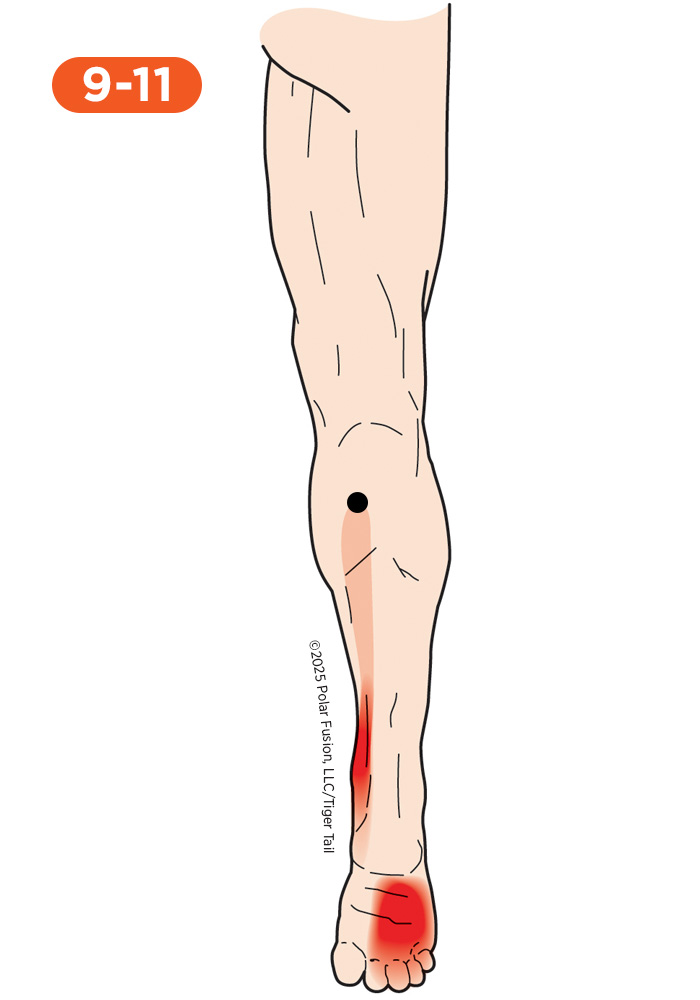
I Feel
Achy Pain on Bottom of Foot
You know that achy feeling you get at the bottom of your foot? Often, people don’t realize that the pain isn’t coming from their foot—it’s traveling down from a muscle in the lower leg called the flexor digitorum longus. This muscle is responsible for curling your toes. The pain usually feels like a deep, persistent ache that settles in your arch and spreads across the sole of your foot, sometimes even reaching back toward your heel. It’s one of those pains that constantly nag at you. When does it really flare up? You’ll notice it’s especially bad when you’re barefoot on hard surfaces—like tile or concrete floors. Sprinting or running makes it worse, as does anything that really grips your toes, prolonged standing, or putting a lot of pressure on your arch. The tricky part is that this pain feels identical to more common foot problems like plantar fasciitis or tibialis posterior tendonitis.

I Feel
Achy Pain on Bottom of Foot
That persistent, achy pain at the bottom of your foot is often referred pain caused by tight muscle knots in the main arch supporter, the tibialis posterior. What you’ll feel is a deep, dull ache that settles into your inner arch and can spread across the bottom of your foot, sometimes radiating up toward your inner ankle. You’ll notice the pain worsening when walking on uneven ground, going upstairs, standing for long periods, running, or doing any activity that involves pushing off and loading the inner arch. Here’s what makes this tricky – since the tibialis posterior is your primary arch-supporting muscle, when it becomes knotted, it sends pain right into the bottom of your foot, which can feel just like plantar fasciitis or flat feet. Press along the inside of your shin, about halfway down your lower leg. The muscle will probably be tender and sensitive, and your foot may feel weak and unstable—like your arch wants to collapse inward and you can’t get a solid push-off when walking.

I Feel
Achy Pain on Bottom of Foot
That chronic ache at the bottom of your foot is a common referral pattern from tight muscle knots in the strong, deep calf muscle, the soleus. The discomfort usually concentrates deep in the heel and arch, manifesting as a dull, deep ache that can feel like a constant bruise. You’ll notice the pain worsens significantly when engaging in endurance activities, such as walking long distances, standing for hours, or running uphill. Because the soleus attaches directly to the heel, its knots can easily mimic more serious issues, such as plantar fasciitis or heel spurs. The deep inner calf tissue is often sensitive to pressure, causing the heel to feel guarded and restricted, especially during those painful first steps in the morning..
Heel Pain
When you experience general heel pain, the cause is often deep muscle knots in the powerful, deep calf muscle called the soleus. You might feel a deep, throbbing ache right in the center of your heel, like a constant bruise, and it can be so intense that it feels like something is stuck inside. The pain typically worsens when you’re running, standing for long periods, walking uphill, climbing stairs, or especially during those first steps in the morning when you get out of bed and put weight on your foot. Here’s what makes this confusing – because your soleus connects directly to your heel bone via your Achilles tendon, when it develops muscle knots, it sends pain straight into your heel. This pain can feel exactly like plantar fasciitis, heel spurs, or Achilles tendinitis. The deep inner calf tissue is often very sensitive to pressure, which can leave the heel feeling guarded and restricted, particularly when putting weight on it after rest.
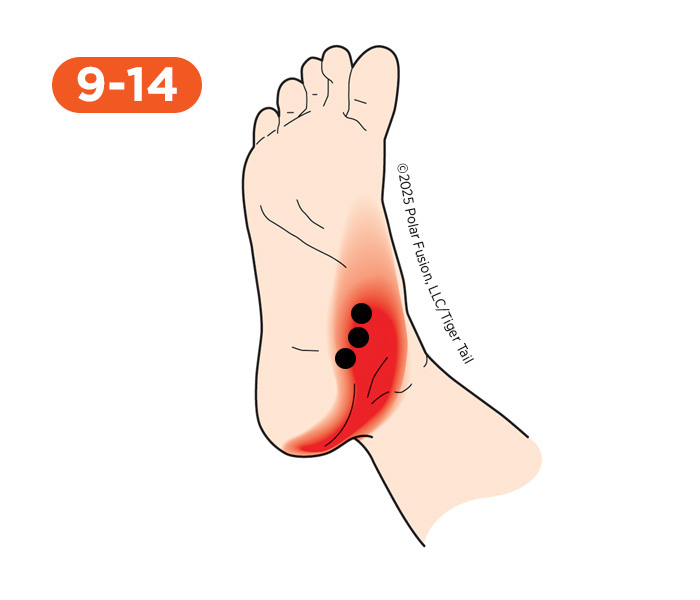
I Feel
Inside of Heel Pain
That sharp, localized pain on the inside of your heel is often caused by tight muscle knots in the main arch muscle, the abductor hallucis. The discomfort typically focuses along the inner edge of the heel bone and arch, appearing as a sharp, stabbing pain with each step. The pain tends to worsen during activities that require arch support, such as walking barefoot, running, or standing for long periods. Since this muscle supports the arch and big toe, its knots can easily mimic more serious issues like plantar fasciitis or tarsal tunnel syndrome. The tissue along the inner arch and heel can become sensitive to pressure, making the foot feel guarded and restricted, especially during the initial heel strike.
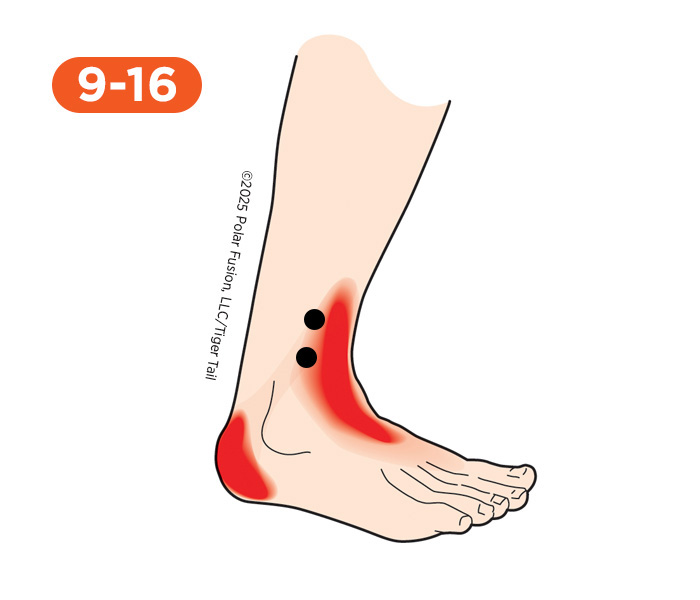
I Feel
Heel Pain
That confusing heel pain can occasionally be referred pain coming from tight muscle knots in the small muscle on the front of your outer shin, the peroneus tertius. The discomfort usually focuses deep in the heel, presenting as a dull, persistent ache that makes your foot feel heavy. You’ll find the pain gets significantly worse when you’re doing activities that require pulling your foot up, like hiking up steep terrain, running, or walking on uneven ground. Because this muscle helps with foot clearance, its muscle knots can easily mimic deeper problems like Plantar Fasciitis or Achilles Tendinopathy. The muscle on the front of the shin is often susceptible to pressure, leaving the heel feeling restricted and heavy and limiting smooth heel-to-toe action with walking.
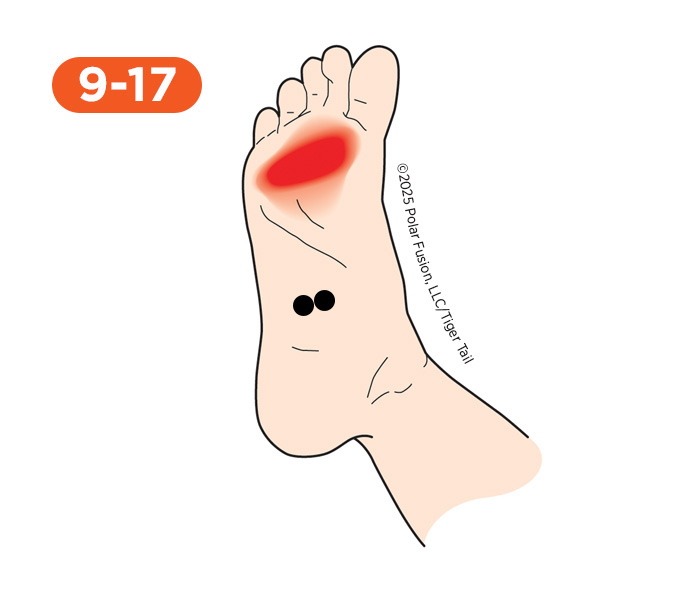
I Feel
Ball of Foot Pain
That painful ache across the ball of your foot is frequently caused by tight muscle knots in the small muscle under the arch, the flexor digitorum brevis. The discomfort usually focuses right across the ball of the foot and feels like a sharp, pinching ache that feels worse when standing. You’ll find the pain gets significantly worse when you’re doing activities that stress the arch, like walking barefoot on hard surfaces, running, or standing for long periods. Because this muscle supports the arch, its knotting can easily mimic deeper problems like Morton’s Neuroma or metatarsalgia. The tissue deep in the arch is often extremely sensitive to pressure, and it leaves the forefoot feeling constricted and painful, limiting your mobility.
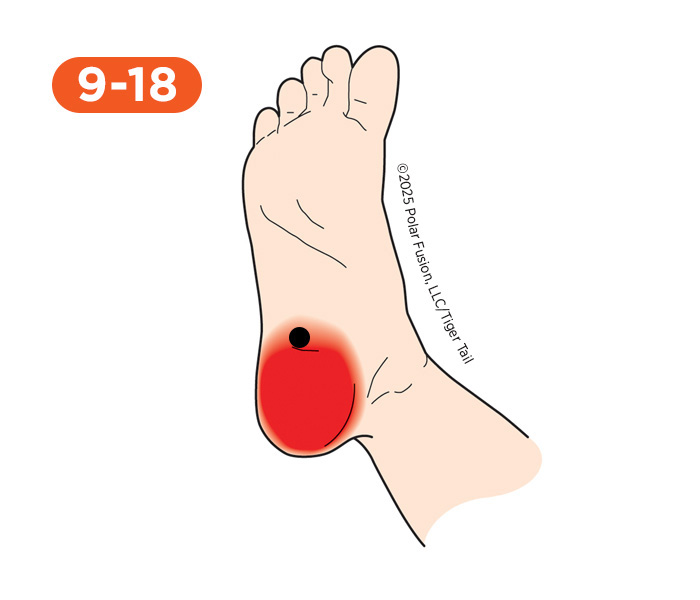
I Feel
Heel Pain
That deep heel pain that won’t go away might stem from tight muscle knots in a square-shaped muscle deep in your arch called the quadratus plantae. What you’ll notice is a deep, constant throbbing right in the middle of your heel – often described as feeling like someone stuck something sharp in there, like a puncture wound. You’ll really feel the pain intensify when you’re walking quickly, running, pushing off to stand up from a chair, climbing stairs, or basically any time you’re putting weight on that foot. Here’s what makes this tricky – because this muscle helps control how your toes flex and grip, when it gets knotted up, it can feel exactly like plantar fasciitis or even a heel spur, which are the things most people assume they have. If you press into the tissue deep in your arch, just in front of your heel bone, it’ll probably be extremely tender and sensitive, and your heel will feel guarded and stiff – like your foot just doesn’t want to roll through your step the way it’s supposed to.
Toe Pain
Muscle knots in the muscle on the outside of the shinbone can cause pain at the big toe and pain on the top of the foot. Other symptoms may include a feeling of drop foot, pain when moving the ankle, and turf toe. Muscle knots controlling toe movements can cause pain in the toes and on the bottom of the toes.
Causes
Toe Pain: Hyperpronation: This describes an excessive inward rolling of the foot during walking or running. Over time, hyperpronation can contribute to pain and injury in the ankles, shins, knees, and even hips due to misalignment of the skeletal and muscular system.
Overload of the muscle when walking, jumping, or running: Jumping, running, and walking all place a significant amount of stress on the muscles of the feet, and can lead to a condition known as muscle overload. Activities like running and jumping, which involve repetitive, high-impact forces, can especially strain the foot’s intricate network of muscles, tendons, and ligaments. This chronic stress can result in the formation of painful muscle knots, particularly in areas like the plantar fascia on the bottom of the foot, or in the calf muscles that connect to the heel. When these muscles become overworked and tight, they can cause localized pain. They may also refer pain to other areas of the toes and foot, making everyday movements and athletic activities difficult.
Wearing High Heels: When you wear heels, your foot is pushed into an unnatural position, compressing your toes together and placing a significant amount of pressure on the ball of your foot. This constant strain can lead to painful muscle knots, especially in your calves and the muscles in your feet, as they work overtime to maintain your stability.
Running or walking on uneven surfaces: Walking or running on uneven surfaces can significantly contribute to ankle pain and instability. The constant micro-adjustments your calf muscles must make to maintain balance on uneven surfaces lead to their overuse and a higher likelihood of developing muscle knots. These muscle knots in overworked calf muscles can then contribute to instability, making you more prone to ankle rolls or sprains.
Running or walking in worn-out shoes: This can significantly contribute to foot and toe pain by altering your natural running and walking patterns. As the cushioning and support break down, your foot and ankle must work harder to absorb impact and maintain body stability. This extra effort can lead to the overuse of muscles in the calf and foot, promoting the development of painful muscle knots. These knots not only cause localized pain but can also lead to instability and referred pain patterns, making you more susceptible to ankle sprains and chronic discomfort.

I Feel
Foot Slap
If you notice your foot making an audible ‘slapping’ sound when you walk, the cause is often weakness and muscle knots in the muscle that lifts the toes, the extensor digitorum longus. The resulting discomfort usually focuses on the front of the shin, presenting as a dull, burning ache that worsens with repetitive use. You’ll notice the foot slap and pain worsen when you’re doing endurance activities like running on flat ground, walking quickly, or hiking long distances. Since the extensor digitorum longus is supposed to gently lower the foot, its muscle knots and fatigue can easily mimic deeper issues, such as peroneal nerve dysfunction or severe shin splints. The muscle along the outer front of the shin can make the foot feel heavy and restricted, hindering a smooth heel-to-toe step.
Drop Foot
If you’re experiencing symptoms like drop foot or an inability to lift your toes, the cause could be muscle knots and tightness in the toe extensor muscle, the extensor digitorum longus. This discomfort typically radiates along the outer front of the shin, presenting as a deep, constant ache that makes the foot feel heavy. You may notice weakness and tripping worsen during activities that require toe clearance, such as walking on uneven terrain, climbing stairs, or stepping over a curb. Because the extensor digitorum longus is vital for lifting the toes, its muscle knots can easily resemble more serious issues like nerve impingement from the low back or common fibular nerve palsy. The muscle along the shin can cause the foot to feel restricted and heavy, forcing you to drag your toes.
Hammer Toe
That painful contraction leading to a hammer toe deformity is often caused by chronic tightness and muscle knots in the toe extensor muscle, the extensor digitorum longus. The discomfort usually focuses on the bent joint of the toe and the ball of the foot, presenting as a sharp, pinching pain during activity. You’ll find the pain worsens when you’re engaging in activities that cramp the toes, such as wearing tight shoes, running, or standing for long periods. Because the extensor digitorum longus is constantly pulling the toe upward, its muscle knots can easily mimic deeper problems like capsulitis or rheumatoid arthritis. The muscle along the outer front of the shin can leave the toe feeling stiff and restricted, preventing it from lying flat.
Claw Toes
You know that painful curling of the toes—what we call claw toe? It’s often caused by chronic tightness and muscle knots in the long muscle running down the front of your shin that helps lift your toes, the extensor digitorum longus. When this muscle tightens or develops muscle knots, it pulls the toes upward, keeping them from lying flat, which can lead to a claw-like shape. The pain usually appears in the bent joints of the toes and the ball of the foot, and it can feel sharp or pinching—especially when you’re active. You’ll probably notice it worsens when your toes are cramped, like in tight shoes, or when you’re running or standing for long periods. What’s tricky is that extensor digitorum longus tightness can feel a lot like other issues, such as capsulitis or shortened ligaments in the toes, so it’s easy to misread. If you press along the outer front of your shin and it’s very tender, that’s a clue. That sensitivity often comes with stiff, restricted toes that won’t relax into your shoes.

I Feel
Foot Slap
A foot slap isn’t really a pain, but more like how your foot hits the ground when you walk caused by muscle knots in the extensor hallucis longus. If you have it, you might notice you have to lift your knee extra high to keep your toes from dragging, and your foot might feel a bit heavy as you swing it forward. Instead of a smooth heel-to-toe step, your whole foot or the front part might just kind of “slap” down, and you might even be tripping more. It’s more of a weird way of walking than a specific feeling of pain in your foot itself. You might also notice that the muscle along the front of your shin is tender to the touch, and that your whole foot feels heavy and restricted. Basically, when your extensor hallucis longus isn’t working correctly, it can’t gently lower your foot with each step, which is why you’re getting that audible foot slap and difficulty walking smoothly.
Hammer Toe

I Feel
Pain in the Second Toe
That nagging pain you feel specifically in your second toe is frequently caused by tight muscle knots in the small muscle between the long bones of the foot, the first dorsal interosseous. The discomfort usually focuses at the base of the second toe and in the web space, presenting as a sharp, specific ache that feels like something is pinching deep inside. You’ll find the pain gets worse when you’re doing activities that splay the toes, like running in wide shoes, walking barefoot, or stepping off a curb. Because this muscle moves the second toe, its muscle knots can easily mimic deeper problems, such as capsulitis or a Morton’s Neuroma (nerve issue). The tissue right between the first and second toes is often extremely sensitive to pressure, and it leaves the toe feeling stiff and restricted, especially when you try to spread your toes apart.

I Feel
Turf Toe
If you’re experiencing a deep ache that feels like turf toe but isn’t originating from the joint itself, it could be tight muscle knots in the muscle that runs down the front of your shin and helps control foot movement, the tibialis anterior. The pain often presents as a dull throb or a sharp stab right at the base of the big toe, and it can radiate along the top of the foot or even up toward the shin. This area tends to be sensitive to pressure, and the discomfort can feel deep and tight, almost as if the joint is being pulled from within. You’ll notice it worsens significantly when doing activities like walking uphill, lunging, wearing shoes with poor arch support, or standing for long periods. Movements that stretch the front of the foot—such as pointing your toes or stepping quickly—can also trigger it. Since this muscle helps stabilize the foot and ankle, its tightness can mimic deeper issues such as joint inflammation or nerve irritation. The result is a foot that feels tight and restricted, leading to a stiff big toe joint that’s harder to move, especially during push-off.
Foot Slap
If your foot makes a slapping noise every time you walk, the culprit is usually weakness and muscle knots in the main muscle running down the front of your shin —the tibialis anterior. You’ll typically feel a dull, burning ache along the front of your shin that progressively gets worse the more you’re on your feet. This foot slap and discomfort get significantly worse when you’re running on flat surfaces, walking briskly, hiking for extended periods, going downhill, or climbing stairs. What’s happening is that your tibialis anterior controls how your foot lands with each step. Still, when it’s tight and fatigued from muscle knots, it basically gives out – which is why you hear that slapping sound. The confusing part is that these symptoms can easily mimic deeper problems like nerve issues or bad shin splints, so many people think something more serious is wrong. You’ll likely find that pressing on the muscle along the front of your shin is extremely sensitive, and your foot feels heavy and clunky – making it difficult to walk with that smooth, controlled heel-to-toe rhythm you’re supposed to have.
Drop Foot
If you’re experiencing symptoms like drop foot or an inability to lift your foot, the cause could be tightness and muscle knots in the main ankle-lifting muscle, the tibialis anterior. The discomfort typically focuses along the outer front of the shin, presenting as a deep, constant ache that makes the foot feel heavy. You may notice that weakness and tripping worsen during movements that require toe clearance, such as walking on uneven terrain, climbing stairs, or stepping over a curb. Because the tibialis anterior is crucial for lifting the foot, its knotting can easily mimic more serious issues like nerve impingement from the lower back or common fibular nerve palsy. The muscle along the front of the shin is often sensitive to pressure and can cause the foot to feel restricted and heavy, forcing you to drag your toes.

I Feel
Claw Toes
That painful contraction leading to claw toes is often caused by chronic tightness and muscle knots in the deep muscle that curls the big toe, the flexor hallucis longus. The discomfort usually focuses deep in the arch and base of the toes and feels like a deep, grasping ache, as if the toes are permanently pulled under. The pain can worsen during activities that require gripping, like walking barefoot, running, or standing for long periods. Because the flexor hallucis longus is constantly pulling the big toe downward, its muscle knots can easily mimic deeper problems, such as severe joint contractures or ligament shortening. The deep calf muscle can leave the toes feeling stiff and restricted, preventing the arch from relaxing.
Pain on the Bottom of the Big Toe
If you’re dealing with that stubborn pain right on the bottom of your big toe, it’s often caused by deep-seated muscle knots in the muscle that curls your big toe downward, the flexor hallucis longus. What you’ll typically feel is a deep, nagging ache right under your big toe joint that gets worse every time you push off your foot. The pain gets worse when you’re doing forceful push-offs like sprinting, jumping, walking or running uphill, doing calf raises, or even just walking on your tiptoes. Here’s what’s happening: the flexor hallucis longus tendon runs directly underneath that big toe joint, so when the muscle develops knots, it creates friction and inflammation right in that spot – which can easily mimic deeper problems like sesamoiditis or even a tendon tear. You’ll probably notice that when you press deep into the back of your calf, the muscle is sensitive to pressure, and your big toe feels stiff and restricted – making it difficult to get that smooth, pain-free push-off when you walk or run.
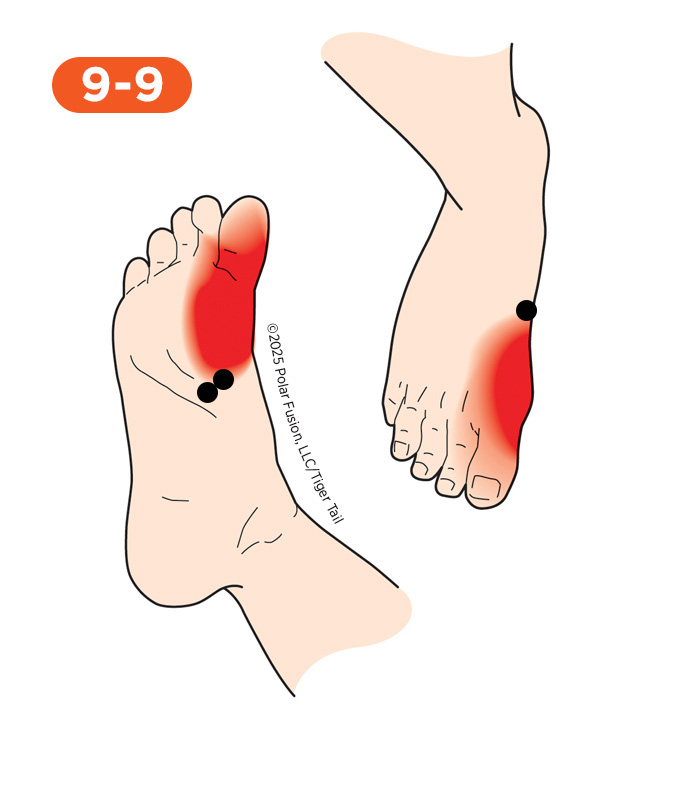
I Feel
Bunion Like Pain
If you experience a sharp pain right at the base of your big toe that feels like a bunion, here’s what might really be happening: it could stem from a tiny muscle beneath your big toe joint called the flexor hallucis brevis. This muscle can develop knots, causing a sharp, pinching pain exactly where your big toe connects to your foot, especially when you push off to walk. You’ll notice it worsening when walking quickly, running, wearing shoes that bend easily—like flip-flops or worn-out sneakers—jumping, or even just standing on your tiptoes. The confusing part is that this pain is very similar to an actual bunion or a condition called sesamoiditis, leading many to think their bone is the issue when it’s this tight little muscle acting up. If you press on the ball of your foot near your big toe, it’s likely to be tender and sore, and your toe may feel stiff or locked up, making it hard to push off properly when you walk—as if your foot isn’t cooperating.
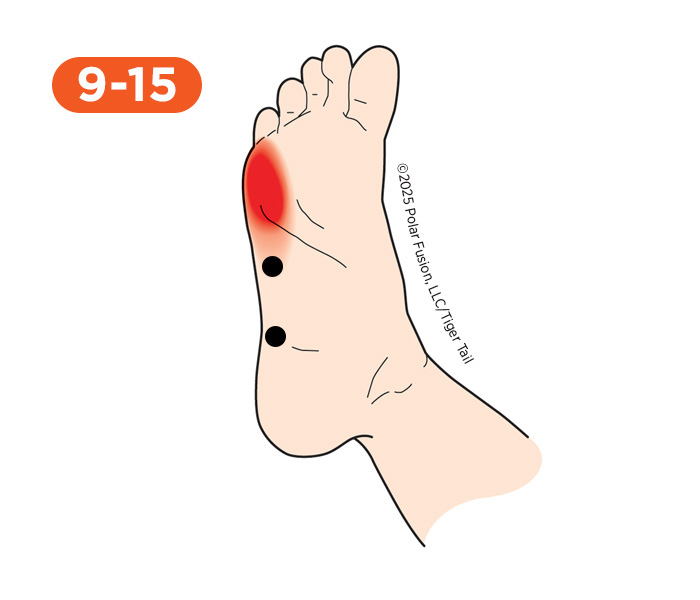
I Feel
Pinky Toe Pain
That stubborn pinky toe pain is often caused by tight muscle knots in the muscle that controls it, the abductor digit minimi of the foot. The discomfort usually focuses on the base and outside edge of the little toe, presenting as a sharp, pinching ache that feels worse when walking. You’ll find the pain worsens during activities that squeeze the forefoot, wearing narrow shoes, running on the forefoot, or walking barefoot. Because this muscle runs along the outer edge of the foot, its muscle knots can easily mimic deeper problems, such as bursitis or a stress fracture in the toe. The tissue along the outer edge of the foot is extremely sensitive to pressure, leaving the little toe feeling stiff and restricted, especially when you wear enclosed shoes.
